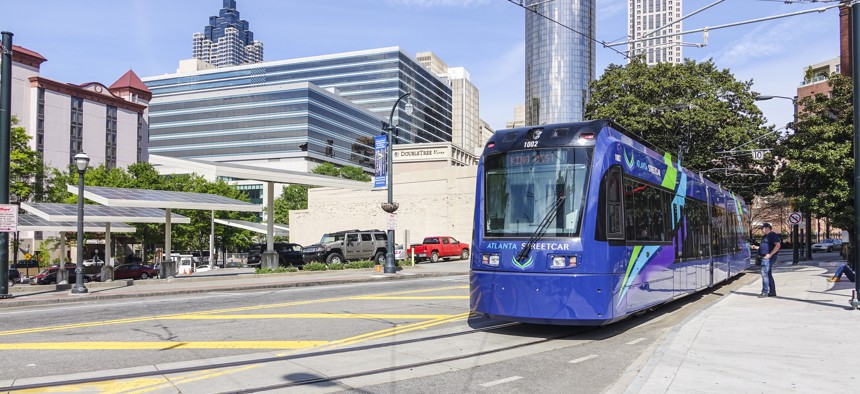U.S. DOT Opens Latest Round of TIGER Grant Funding. Will It Be the Last?

A streetcar in Atlanta, on April, 2016. Shutterstock.com/ 4kclips

Connecting state and local government leaders
President Trump has proposed axing funding for the transportation program. There’s disagreement between the House and Senate on whether to go along with that plan.
WASHINGTON — State and local governments will have a chance in the coming weeks to vie for a portion of $500 million in federal transportation funding through a popular grant program that President Trump has called for eliminating.
The U.S. Department of Transportation said Wednesday it was opening up this year’s application process for Transportation Investment Generating Economic Recovery, or TIGER, grants, which were created under the Obama administration during the Great Recession.
Selection criteria for the grants will remain “fundamentally the same” as it has in previous years, according to the Transportation Department. Although the department did note that there would be “special consideration” given to certain projects in rural areas.
Oct. 16 is the deadline to submit an application.
Congress allocated $500 million for the program in a budget package approved in May. That money is available through Sept. 30, 2020. The Transportation Department’s press office said in an email that the plan is to award all of the available money in this round of funding.
Trump proposed axing all of the money for TIGER grants in the budget proposal for the upcoming fiscal cycle that he submitted to Congress earlier this year. The president’s budget plan said that TIGER provides federal funding “for projects with localized benefits, and often these projects do not rise to the level of national or regional significance.”
Transportation Secretary Elaine Chao, in a statement Wednesday, offered a noncritical take on the grants.
“The TIGER grant program is a highly competitive program whose winners will be awarded with the funding they need to rebuild the infrastructure of their communities,” she said.
Chao added that the “grants will continue to fund innovative projects that will improve the safety of America’s passengers and goods.”
Congressional appropriators in the House and Senate have taken different positions on whether to fund TIGER grants in fiscal year 2018. A House appropriations bill that covers transportation does not include money for the grants. But a Senate bill provides $550 million.
A similar dynamic has played out in prior years where the House proposes slashing the program, the Senate backs funding, and ultimately money gets allocated for the grants.
Under current law, TIGER grants can’t be less than $5 million or greater than $25 million, except for projects located in rural areas, where the minimum grant size is $1 million.
The Transportation Department indicated in its announcement that it would be keeping an eye out for project proposals that “emphasize improved access to reliable, safe, and affordable transportation” for rural communities—and particularly projects in these places that might address public health and safety and boost economic growth and competitiveness.
TIGER dollars have previously gone to projects such as a streetcar line in Atlanta, and safety improvements in New Mexico on U.S. 491, a rural highway in the Four Corners region.
During eight previous TIGER funding rounds, the Department of Transportation has awarded about $5.1 billion in grants.
Applications tend to far exceed the grant money available through the program. In 2016, the the agency received 585 eligible applications from all 50 states.
Bill Lucia is a Senior Reporter for Government Executive’s Route Fifty and is based in Washington, D.C.

NEXT STORY: Microsoft adds Blob Storage to government regions





